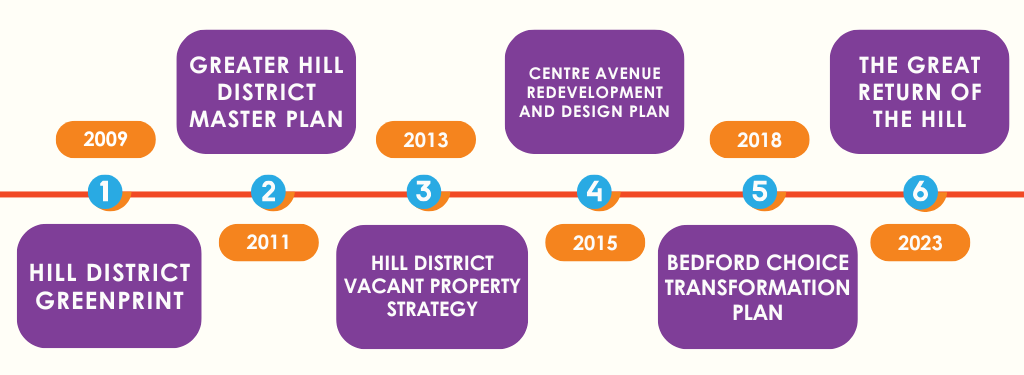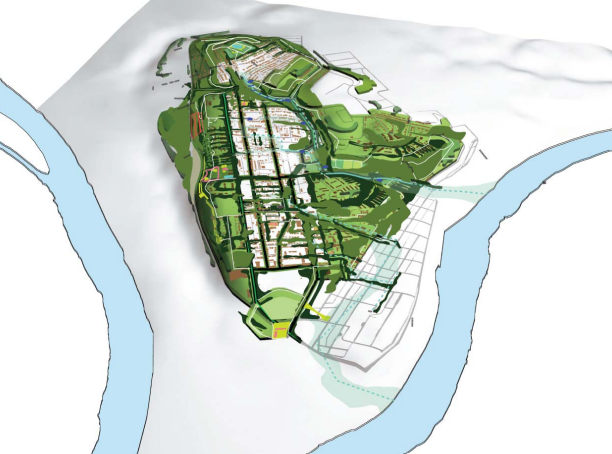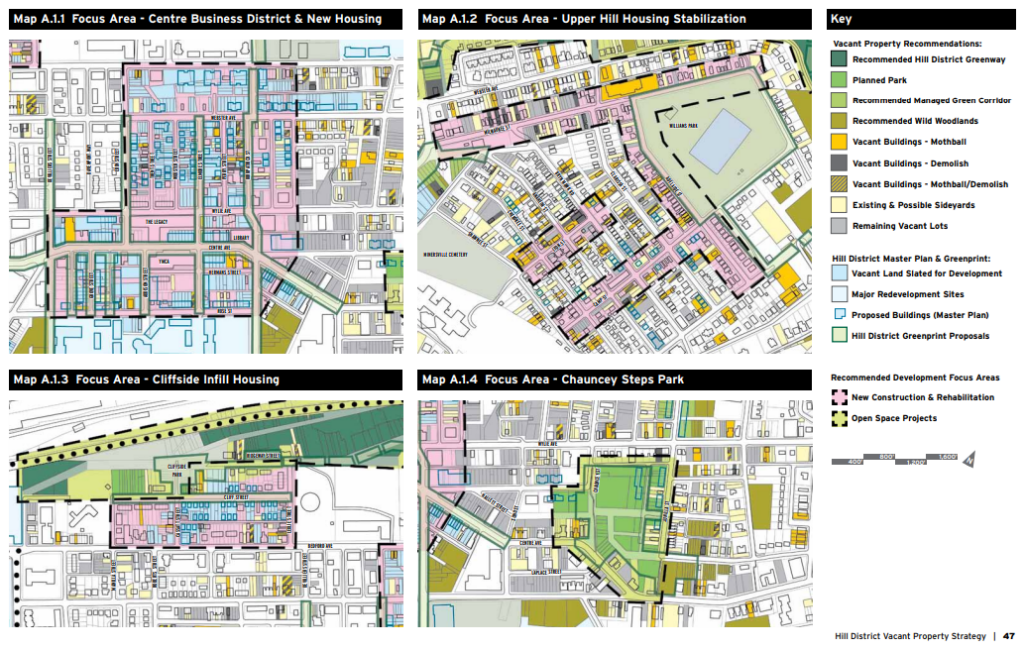
As the Hill District continues to grow, it is important to ensure opportunities are tailored to address the desires of our community’s residents. This page contains the numerous plans and studies completed over time which guide the work of the Hill CDC as we foster new growth and reinvestment into the Hill District.
The Greenprint (2009) created a bold vision for a natural and healthy community and the Greater Hill District Master Plan (2011) established fundamental values and development principles that have been central to development activities and the neighborhood ecosystem since.
The Vacant Property Strategy (2013) outlined how just under half of all vacant properties are publicly owned between the City of Pittsburgh, the Urban Redevelopment Authority, and the Housing Authority. Today, vacant property is one of the Hill District’s greatest challenges, but it can be leveraged to foster equitable development.
The Centre Avenue Redevelopment and Design Plan (2015) created a detailed vision, using market studies as the basis, for how new development and amenities on the vacant lots along Centre Avenue could serve a variety of community needs and catalyze further investment.
The Bedford CHOICE Transformation Plan (2018) aspires to make replacing 411 public housing units at Bedford Dwellings with 826 new units at multiple sites in the Hill District an opportunity to design and develop meaningful connections between the neighborhood’s assets and to re-form the mixed-income, mixed-use community that was once the Hill District.
Finally, after collaboration with local residents, The Great Return of the Hill (2023) maps viable recommendations to activate the Hill District’s Centre Avenue as a thriving Black cultural, commercial and innovation corridor.
Read more about these and other important neighborhood plans (available for download as PDFs) below.
Downloads:
| Documents: | Size: | |
|---|---|---|
 |
2009 Hill District Greenprint | 41.92 MB |
 |
2011 Greater Hill District Master Plan | 19.99 MB |
 |
2011 Herron Avenue Revitalization Planning Strategy | 2.91 MB |
 |
2013 Hill District Vacant Property Study | 6.91 MB |
 |
2014 UDream Studio's Plan for Centre Avenue between Reed and Herron | 24.26 MB |
 |
2015 Centre Avenue Corridor Redevelopment and Design (CARD) Plan | 23.33 MB |
 |
2016 PWSA Green First Plan | 79.23 MB |
 |
2018 Bedford Connects Transformation Plan | 36.23 MB |
 |
2020 Updated Bedford Connects Transformation Plan | 24.18 MB |
 |
2022 Hill District Transportation Study | 13.69 MB |
 |
2023 The Great Return of the Hill | 19.60 MB |
Hill District Greenprint (2009)
The Hill District Greenprint outlines a community-driven vision for sustainable development and environmental stewardship in Pittsburgh’s Hill District.

Read More Here
By combining sustainability with cultural preservation, the Greenprint aims to honor the Hill District’s heritage while addressing modern challenges like climate change and disinvestment. Ultimately, it serves as a framework for fostering economic growth and community well-being through environmentally conscious and inclusive practices.
It prioritizes creating green infrastructure to manage stormwater, reduce urban heat, and enhance public spaces while fostering ecological resilience. The plan identifies key sites for greenway development, urban agriculture, and tree planting to promote environmental equity and neighborhood connectivity. It emphasizes integrating green design into new and existing developments to create healthier, more livable spaces for residents.
Greater Hill District Master Plan (2011)
The 2011 Greater Hill District Master Plan provides a comprehensive framework to guide revitalization efforts in Pittsburgh’s historic Hill District, with a focus on equitable development.

Read More Here
The plan is comprised of eight urban design proposals that address opportunities to improve the physical environment . Each proposal is comprised of projects that address community goals both individually and collectively. The urban design proposals are designed to be site specific and capable of independent implementation, while complementing previous planning initiatives. They also vary in scale and complexity, but each are further strengthened by a number of program initiatives that address non-physical implementation.
- Lower Hill (p. 74): Redevelop the Lower Hill as a vibrant mixed-use district that bridges the Hill District with Downtown, emphasizing connectivity, housing, and commercial opportunities.
- Crawford Corridor (p. 78): Transform Crawford Street into a central residential corridor with enhanced pedestrian access, streetscape improvements, and community services.
- Uptown Opportunities (p. 82): Leverage Uptown’s location to attract innovation-focused development while integrating affordable housing and neighborhood amenities.
- Bedford Avenue Corridor (p. 86): Stabilize and enhance Bedford Avenue with improved housing, historic preservation, and community-oriented green spaces.
- Centre View (p. 92): Establish Centre View as a key destination for cultural and community events, incorporating public plazas, local retail, and residential spaces.
- Kirkpatrick Street Recreational Corridor (p. 100): Create a recreational corridor along Kirkpatrick Street with enhanced greenways, park spaces, and connections to recreational facilities.
- Herron Avenue (p. 108): Develop Herron Avenue as a gateway corridor focused on workforce development, light industry, and improved transportation links.
- Upper Hill (p. 112): Strengthen the Upper Hill as a primarily residential area with targeted investments in housing, public spaces, and community facilities.
The Master Plan emphasizes community-driven priorities, such as preserving the neighborhood’s rich African-American heritage and addressing systemic disparities and also identifies key public spaces, like greenways and parks, for improvements to boost quality of life. Infrastructure upgrades, including better public transit and safer streets, aim to reconnect the neighborhood to Downtown and Oakland. Overall, the plan seeks to balance historical preservation with modern development, ensuring long-term sustainability and inclusivity for current and future residents.
Development Principles
- Address/Right Historical Wrongs
- Promote Economic Justice
- Reflect Neighborhood Driven Civic Design
- Promote a Green and Healthy Environment
- Utilize Neighborhood Strengths and Assets
Non-Displacement Strategies
- Economic Opportunities
- Homeowner Support
- Renter Support
- Community Ownership/Equity
Strategies for Reclaiming the Lower Hill
- Design
- Housing
- Business Development
Vacant Property Strategy (2013)
This strategy provides a blueprint for turning blight into opportunity, aiming to balance sustainable growth with preserving the Hill District’s history and heritage.

Read More Here
The plan outlines actionable steps to transform the neighborhood’s more than 800 vacant properties into community assets. One key finding reveals that over 40% of the Hill District’s parcels are vacant, underscoring the extent of blight and disinvestment. The plan identified that of those parcels, over 60% of these properties are publicly owned, which offers a prime opportunity for community-driven redevelopment.
Recommendations include creating a land bank to streamline acquisition and reuse, prioritizing affordable housing, and integrating green infrastructure into vacant lot strategies. The strategy also emphasizes the importance of aligning redevelopment efforts with community goals to prevent displacement and maintain the neighborhood’s cultural identity. Collaborative partnerships, targeted investment, and clear policy tools are identified as critical to addressing the challenges posed by vacant properties.
Centre Avenue Redevelopment and Design Plan (2015)
The Centre Avenue Redevelopment and Design (CARD) Plan outlines a vision for transforming Centre Avenue into the cultural and economic heart of Pittsburgh’s Hill District. At its core are three thematic “Centres” that will shape the corridor’s future.

Read More Here
The Centre of Culture emphasizes preserving the neighborhood’s rich African-American heritage through iconic architecture, public art, and cultural programming. The Centre of Opportunity focuses on fostering economic growth by supporting small businesses, creating mixed-use developments, and ensuring access to jobs and resources. The Centre of Cultivation prioritizes community well-being, featuring green infrastructure, public spaces, and affordable housing to nurture a healthy and connected neighborhood. The plan also promotes walkable streetscapes, sustainable design, and adaptive reuse of key sites to preserve the corridor’s unique character. By aligning with community-driven goals, the CARD Plan ensures that redevelopment is equitable and inclusive. Together, these strategies position Centre Avenue as a thriving, resilient, and vibrant corridor central to the Hill District’s future.
The plan was prepared by evolveEA Sustainable Architecture and 4wardPlanning, using a grant from The Design Center. It incorporates green infrastructure and includes a heritage trail and recommends restoring the stream at the bottom of the Chauncey Street steps for a rainwater park. The plan also includes maps of property ownership, vacant lots, zoning and land use criteria, as well as data on existing housing stock, commercial and institutional properties, demographics, and population changes.
The Hill District has seen an increase of more than 1,000 residents since 2000, which further indicates the need for additional rental and for-sale housing. To serve them and future residents, the CARD Plan calls for retail amenities ranging from boutique clothing shops and restaurants to bakeries and even a fitness center. One ambitious idea in the plan would recreate the “crossroads of the world” by establishing Heritage Square at Centre Avenue and Dinwiddie Street intersection on the site where the Zone 2 police station currently sits within the Centre of Culture.
The CARD Plan was developed from the input of residents and stakeholders into a vision for a future of the Hill District that also pays homage to its past, encompassing housing, commercial and mixed-use development as well as cultural and historic programming.
Bedford Connects Transformation Plan (2018)
This plan creates a comprehensive strategy to revitalize the Bedford Dwellings public housing sites and the surrounding Target Area to improve the quality of life for residents of the Greater Hill District.

Read More Here
In June 2016, the Housing Authority of the City of Pittsburgh (HACP), the City of Pittsburgh and Bedford Dwellings community partners received a $500,000 Choice Neighborhoods Planning Grant from the U.S. Department of Housing and Urban Development (HUD) to comprehensively plan for the redevelopment of Bedford Dwellings and the Middle Hill neighborhood, providing replacement housing for the 411 households in a new mixed-income community. This grant leveraged an additional $710,000 from local government agencies and foundations.
In July 2016, the planning process began with re-convening the Hill District CHOICE Board, first organized in February 2016. The CHOICE Board is comprised of six leading community-based organizations: The City and HACP, the planning coordinator, and a Bedford Dwellings resident representative. In 2018, the Choice Neighborhoods Transformation Plan was finalized out of this process and presented a holistic vision for the redevelopment of the Target Area within the Greater Hill District.
The Greater Hill District is comprised of six neighborhoods: the Upper Hill District, Bedford Dwellings, Middle Hill, Crawford-Roberts, Terrace Village, and Uptown, but the Target Area of the plan consists of Bedford Dwellings, a substantial portion of the Middle Hill, and a small portion of the Crawford Roberts neighborhood.
The Great Return of the Hill (2023)
This report maps viable recommendations to activate the Hill District’s Centre Avenue as a thriving Black cultural, commercial, and innovation corridor.

Read More Here
Across the years, multiple generative studies have been produced that map the needed and ongoing (re)development of the Hill District. This report is not intended to duplicate or be redundant to the existing plans but to weave ideas that most resonate with Hill District community members at this time and offer up a viable road map for energizing Centre Ave in the short to long term.
When inquired about and unraveled through dialogue, a proposed mixture of experiences, essential services, safe havens, businesses, intergenerational social gathering spaces, green spaces, learning centers, food spaces, health and wellness spaces, real estate, and entertainment venues was needed to bring thriving commerce to the Hill.
Also learned in this process was that this activation strategy, although stewarded by the Hill CDC, is about more than just the Hill CDC. It’s about the Hill District, not any one institution. A thriving Black cultural, commercial, and innovation community can only manifest when many come together to advance a shared vision and agenda. An African proverb reveals, “If you want to go fast, go alone. If you want to go far, go together.” These recommendations recognize and enjoin a collective buy-in. They are designed so that every representation within the Hill can see themselves participating somehow. Many activations in this report suggest potential partnerships and ways for members of this incredible community to come together.
